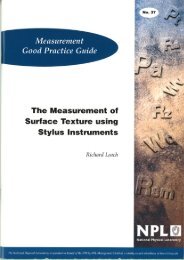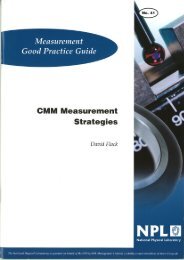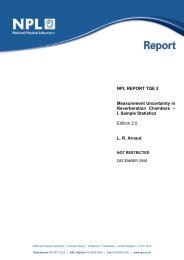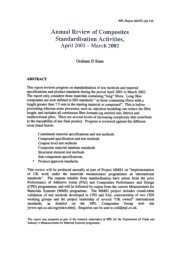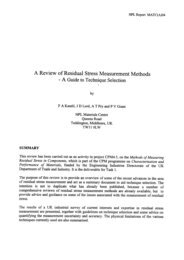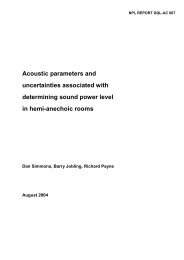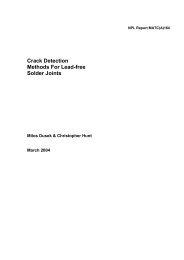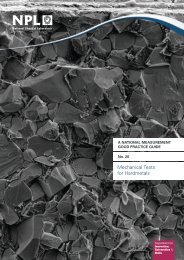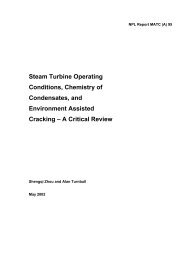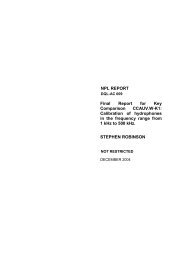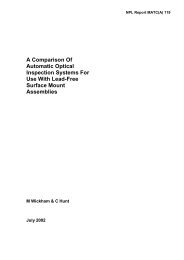Protocol for Establishing and Maintaining the Calibration - NPL ...
Protocol for Establishing and Maintaining the Calibration - NPL ...
Protocol for Establishing and Maintaining the Calibration - NPL ...
Create successful ePaper yourself
Turn your PDF publications into a flip-book with our unique Google optimized e-Paper software.
2 Good Practice Guide 93 Chapter 1<br />
1.1 Introduction<br />
Radioactive materials are widely used in hospitals <strong>for</strong> diagnostic <strong>and</strong> <strong>the</strong>rapeutic purposes. It is<br />
important that <strong>the</strong> activity of <strong>the</strong> radioactive material should be accurately determined prior to<br />
administration to a patient. The principal instrument used to assay <strong>the</strong> radioactivity is <strong>the</strong><br />
radionuclide calibrator (see Figure 1.1).<br />
This instrument normally consists of:<br />
(a)<br />
(b)<br />
(c)<br />
(d)<br />
(e)<br />
Well-type ionisation chamber<br />
Stabilised high voltage supply<br />
Electrometer <strong>for</strong> measuring <strong>the</strong> small ionisation currents<br />
Processing electronics<br />
Display device<br />
Figure 1.1<br />
Radionuclide calibration<br />
Sample<br />
High voltage<br />
supply<br />
DDD.D<br />
MBq<br />
Ionisation<br />
chamber<br />
Electrometer,<br />
processor, display<br />
An ionisation chamber consists essentially of two electrodes at a potential difference of several<br />
hundred volts <strong>and</strong> insulated from each o<strong>the</strong>r by an envelope of gas. Most chambers are sealed <strong>and</strong><br />
<strong>the</strong> gas is usually at a pressure of several atmospheres. The radioactive sample is placed into a<br />
cavity surrounded by <strong>the</strong> chamber. The passage of ionising radiation through <strong>the</strong> sensitive volume<br />
of <strong>the</strong> calibrator ionises <strong>the</strong> gas, producing an electrical current, <strong>the</strong> magnitude of which is<br />
proportional to <strong>the</strong> activity of radionuclide being assayed. The ratio of <strong>the</strong> current to <strong>the</strong> activity is<br />
normally referred to as <strong>the</strong> calibration factor <strong>for</strong> that radionuclide. The calibration factor is not<br />
only dependent on <strong>the</strong> emissions of <strong>the</strong> radionuclide but also on a number of o<strong>the</strong>r factors,<br />
including, <strong>for</strong> example, <strong>the</strong> nature of <strong>the</strong> container <strong>and</strong> volume of solution. The current that is<br />
generated between <strong>the</strong> electrodes typically ranges from 10’s of femtoamperes (fA) up to perhaps<br />
microamperes (μA) – a dynamic range of 10 8 . The electrometer in <strong>the</strong> radionuclide calibrator has<br />
to be capable of making accurate measurements over this large dynamic range.



